Choosing the LID for Urban Storm Management in the South of Taiyuan Basin by Comparing the Storm Water Reduction Efficiency
Abstract
1. Introduction
2. Materials and Methods
2.1. Study Site
2.2. Model Settings
2.2.1. Inflow
2.2.2. Outflow
2.2.3. Subcatchment
2.2.4. Flow Process
2.2.5. Model Calibration and Validation
2.3. Low-Impact Development Facilities
2.4. Performance Metrics Calculation
2.4.1. Indexes
2.4.2. Comparing the Efficiency of the Two Kinds of LIDs
2.4.3. Evaluating the Scale of LIDs
3. Results and Discussion
3.1. The Efficiency of the Two Kinds of LID
3.2. The Scale of Rain Garden
3.3. Performance of Rain Garden
4. Conclusions
- The continuous porous pavement scenario could increase more infiltration than the rain garden, but the rain garden could be more effective at reducing surcharging pipeline, ponding road, external outflow, and surface flow, especially at increasing facility storage.
- With the same LID area and design storm, the rain garden could mitigate the pipeline surcharging and road ponding more efficiently than the continuous porous pavement.
- When the LID area of the rain garden is between 15% and 20%, the rain garden has good performance on reducing the surcharging pipelines.
- It is worth noticing that the LIDs are very much ineffective for less frequent, heavier, and longer duration storms, and the LIDs could not replace conventional runoff management practices and drainage systems.
- We focused on the city flood control of the LID facilities in this paper, so we have not discussed the efficiency related to the environmental function and cost-effectiveness. These issues should be further studied, if they are of concern—nonpoint source pollution reduction, water quality improvement, and cost-effectiveness.
Author Contributions
Funding
Conflicts of Interest
References
- Comprehensive Water Resources Planning in China; Ministry of Water Resources of the People’s Republic of China: Beijing, China, 2010. (In Chinese)
- BAI, Y.; Zhao, N.; Zhang, R.; Zeng, X. Storm Water Management of Low Impact Development in Urban Areas Based on SWMM. Water 2019, 11, 33. [Google Scholar] [CrossRef]
- Zhou, Q.; Leng, G.; Su, J.; Ren, Y. Comparison of urbanization and climate change impacts on urban flood volumes: Importance of urban planning and drainage adaptation. Sci. Total Environ. 2019, 658, 24–33. [Google Scholar] [CrossRef] [PubMed]
- Arnone, E.; Pumo, D.; Francipane, A.; La Loggia, G.; Noto, L.V. The role of urban growth, climate change, and their interplay in altering runoff extremes. Hydrol. Process. 2018, 32, 1755–1770. [Google Scholar] [CrossRef]
- Mahmoud, S.H.; Gan, T.Y. Urbanization and climate change implications in flood risk management: Developing an efficient decision support system for flood susceptibility mapping. Sci. Total Environ. 2018, 636, 152–167. [Google Scholar] [CrossRef] [PubMed]
- Moghadas, S.; Leonhardt, G.; Marsalek, J.; Viklander, M. Modeling urban runoff from rain-on-snow events with the US EPA SWMM model for current and future climate scenarios. J. Cold Reg. Eng. 2018, 32, 04017021. [Google Scholar] [CrossRef]
- Ren, G.; Ren, Y.; Zhan, Y.; Sun, X.; Liu, Y.; Chen, Y.; Wang, T. Spatial and temporal patterns of precipitation variability over mainland China: II: Recent trends. Adv. Water Sci. 2015, 26, 451–465. (In Chinese) [Google Scholar]
- Miller, J.D.; Hutchins, M. The impacts of urbanisation and climate change on urban flooding and urban water quality: A review of the evidence concerning the United Kingdom. J. Hydrol. Reg. Stud. 2017, 12, 345–362. [Google Scholar] [CrossRef]
- Akter, T.; Quevauviller, P.; Eisenreich, S.J.; Vaes, G. Impacts of climate and land use changes on flood risk management for the Schijn River, Belgium. Environ. Sci. Policy 2018, 89, 163–175. [Google Scholar] [CrossRef]
- Todd, C.D.; Goss, A.M.; Tripathy, D.; Harbor, J.M. The effects of landscape transformation in a changing climate on local water resources. Phys. Geogr. 2007, 28, 21–36. [Google Scholar] [CrossRef]
- Huong, H.L.; Pathirana, A. Urbanization and climate change impacts on future urban flooding in Can Tho city, Vietnam. Hydrol. Earth Syst. Sci. 2013, 17, 379–394. [Google Scholar] [CrossRef]
- Ye, B.; Sheng, D.; Men, X. Causes and countermeasures of urban water logging. J. Econ. Water Res. 2011, 28, 62–78. [Google Scholar]
- Long, Y.; Cui, T. Simulating the storm water runoff and drainage of the south urban district in the Taiyuan Basin with a 1D–2D model. In IOP Conference Series Earth and Environmental Science, Changsha, China, 18–20 May 2018; Hsu, C.H., Liu, Z.Q., Wang, H., Qin, M.Z., Eds.; IOP Publishing: Bristol, UK, 2019. [Google Scholar]
- Himanshu, S.K.; Pandey, A.; Yadav, B.; Gupta, A. Evaluation of best management practices for sediment and nutrient loss control using SWAT model. Soil Tillage Res. 2019, 192, 42–58. [Google Scholar] [CrossRef]
- United States Environmental Protection Agency. Low Impact Development (LID) A Literature Review; EPA-841-B-00-005; EPA: Washington, DC, USA, 2000; p. 10.
- Meng, T.; Hsu, D. Stated preferences for smart green infrastructure in stormwater management. Landsc. Urban Plan. 2019, 187, 1–10. [Google Scholar] [CrossRef]
- Johnson, D.; Geisendorf, S. Are Neighborhood-level SUDS Worth it? An Assessment of the Economic Value of Sustainable Urban Drainage System Scenarios Using Cost-Benefit Analyses. Ecol. Econ. 2019, 158, 194–205. [Google Scholar] [CrossRef]
- Radcliffe, J.C. History of Water Sensitive Urban Design/Low Impact Development Adoption in Australia and Internationally. Approaches to Water Sensitive Urban Design; Sharma, A.K., Gardner, T., Begbie, D., Eds.; Elsevier: Amsterdam, The Netherlands, 2019; pp. 1–24. [Google Scholar]
- Ding, N.; Hu, A.; Ren, X. Application and prospect of low impact development model in Shenzhen. Water Wast. Eng. 2012, 38, 141–144. [Google Scholar]
- Long, Y.; Gai, Y.; Guan, X.; Hu, X.; Cui, T. Advance of the Method estimating the Benefit of Storm Water Usage in Urban Area. In IOP Conference Series Earth and Environmental Science, Qingdao, China, 23–25 August 2018; Nield, D.A., Ed.; IOP Publishing: Bristol, UK, 2019. [Google Scholar]
- Guidance on Promoting the Construction of the Sponge City; General Office of the State Council of the People’s Republic of China: Beijing, China, 2015. (In Chinese)
- Li, G.; Suo, N.; Han, S. Make rational use of water resources and vigorously develop rain and flood resources. Mod. Sci. 2012, 12, 121. (In Chinese) [Google Scholar]
- Guo, W.; Liu, W.; Wang, H. Study and Application of Ecological Management of Urban Rain and Flood Resources; China Water Power Press: Beijing, China, 2015. [Google Scholar]
- Freni, G.; Mannina, G.; Viviani, G. Urban storm-water quality management: Centralized versus source control. J. Water Resour. Plan. Manag. 2010, 136, 268–278. [Google Scholar] [CrossRef]
- Whitehead, P.G.; Jin, L.; Macadam, I.; Janes, T.; Sarkar, S.; Rodda, H.J.E.; Sinha, R.; Nicholls, R. Modelling impacts of climate change and socio-economic change on the Ganga, Brahmaputra, Meghna, Hooghly and Mahanadi river systems in India and Bangladesh. Sci. Total Environ. 2018, 636, 1362–1372. [Google Scholar] [CrossRef]
- Wang, X.; Kingsland, G.; Poudel, D.; Fenech, A. Urban flood prediction under heavy precipitation. J. Hydrol. 2019, 577, 123984. [Google Scholar] [CrossRef]
- Wang, M.; Zhang, D.; Lou, S.; Hou, Q.; Liu, Y.; Cheng, Y.; Qi, J.; Tan, S.K. Assessing Hydrological Effects of Bioretention Cells for Urban Stormwater Runoff in Response to Climatic Changes. Water 2019, 11, 997. [Google Scholar] [CrossRef]
- Bosley, E.K. Hydrologic Evaluation of Low Impact Development Using a Continuous, Spatially-Distributed Model. Master’s Thesis, Virginia Polytechnic Institute and State University, Blacksburg, Virginia, 2008. [Google Scholar]
- Eckart, K.; McPhee, Z.; Bolisetti, T. Performance and implementation of low impact development—A review. Sci. Total Environ. 2017, 607–608, 413–432. [Google Scholar] [CrossRef] [PubMed]
- Cipolla, S.S.; Maglionico, M.; Stojkov, I. A long-term hydrological modelling of an extensive green roof by means of SWMM. Ecol. Eng. 2016, 95, 876–887. [Google Scholar] [CrossRef]
- Zheng, Y.; Chen, S.; Qin, H.; Jiao, J.J. Modeling the Spatial and Seasonal Variations of Groundwater Head in an Urbanized Area under Low Impact Development. Water 2019, 10, 803. [Google Scholar] [CrossRef]
- Liu, Y.; Ahiablame, L.M.; Bralts, V.F.; Engel, B.A. Enhancing a rainfall-runoff model to assess the impacts of BMPs and LID practices on storm runoff. J. Environ. Manag. 2015, 147, 12–23. [Google Scholar] [CrossRef]
- Bai, Y.; Li, Y.; Zhang, R.; Zhao, N.; Zeng, X. Comprehensive Performance Evaluation System Based on Environmental and Economic Benefits for Optimal Allocation of LID Facilities. Water 2019, 11, 341. [Google Scholar] [CrossRef]
- Mao, X.; Jia, H.; Yu, S.L. Assessing the ecological benefits of aggregate LID-BMPs through modelling. Ecol. Model. 2017, 353, 139–149. [Google Scholar] [CrossRef]
- Helmi, N.R.; Verbeiren, B.; Mijic, A.; Griensven, A.; Bauwens, W. Developing a modeling tool to allocate Low Impact Development practices in a cost-optimized method. J. Hydrol. 2019, 573, 98–108. [Google Scholar] [CrossRef]
- Urban Master Planning of Taiyuan (2011–2020); People’s government of Taiyuan: Taiyuan, China, 2015. (In Chinese)
- Special Planning for Sponge City of Taiyuan (2016–2020); China Academy of Urban Planning & Design, Taiyuan Urban & Rural Planning and Design Research Institute: Taiyuan, China, 2014. (In Chinese)
- PCSWMM Features. Available online: https://www.pcswmm.com/Features (accessed on 6 June 2019).
- Taiyuan Drainage and Waterlogging Construction Plan (2014–2020); Taiyuan Urban & Rural Planning and Design Research Institute: Taiyuan, China, 2015. (In Chinese)
- Special Planning for Urban Flood Control and Drainage of Taiyuan City (2013–2020); Taiyuan Urban Planning and Design Institute, Taiyuan Municipal Construction Group Co., LTD., Taiyuan Water Conservancy Survey and Design Institute: Taiyuan, China, 2015. (In Chinese)
- Horton, R.E. An approach toward a physical interpretation of infiltration capacity. Soil Sci. Soc. Am. J. 1940, 5, 399–417. [Google Scholar] [CrossRef]
- Avoiding Double Accounting of Channel Volume. Available online: https://support.chiwater.com/78047/avoiding-double-accounting-of-channel-volume (accessed on 6 June 2019).
- Dietz, M.E. Low impact development practices: A review of current research and recommendations for future directions. Water Air Soil Pollut. 2007, 186, 351–363. [Google Scholar] [CrossRef]
- LID Controls. Available online: https://support.chiwater.com/77701/lid-controls (accessed on 6 June 2019).
- Technical Specification for Pavement of Water Permeable Brick; Ministry of Housing and Urban Rural Development of the People’s Republic of China: Beijing, China, 2012. (In Chinese)
- William, M. Landscape Planning: Environmental Application, 5th ed.; John Wiley & Sons, Inc.: New York, NY, USA, 2010. [Google Scholar]
- Technical Code for Rainwater Collection, Storage and Utilization; Ministry of Housing and Urban Rural Development of the People’s Republic of China, General Administration of Quality Supervision, Inspection and Quarantine of the People’s Republic of China: Beijing, China, 2010. (In Chinese)
- Li, J.; Zhang, B.; Li, Y.; Li, H. Simulation of Rain Garden Effects in Urbanized Area Based on Mike Flood. Water 2018, 10, 860. [Google Scholar] [CrossRef]
- Zhang, S.S.; Pan, Y. SWMM model-based study on optimal allocation of LID facilities in urbanized region. Water Res. Hydrol. Eng. 2018, 49, 10–15. (In Chinese) [Google Scholar]
- Wang, M.; Zhang, D.; Adhityan, A.; Ng, W.J.; Dong, J.; Tan, S.K. Assessing cost-effectiveness of bioretention on stormwater in response to climate change and urbanization for future scenarios. J. Hydrol. 2016, 543, 423–432. [Google Scholar] [CrossRef]
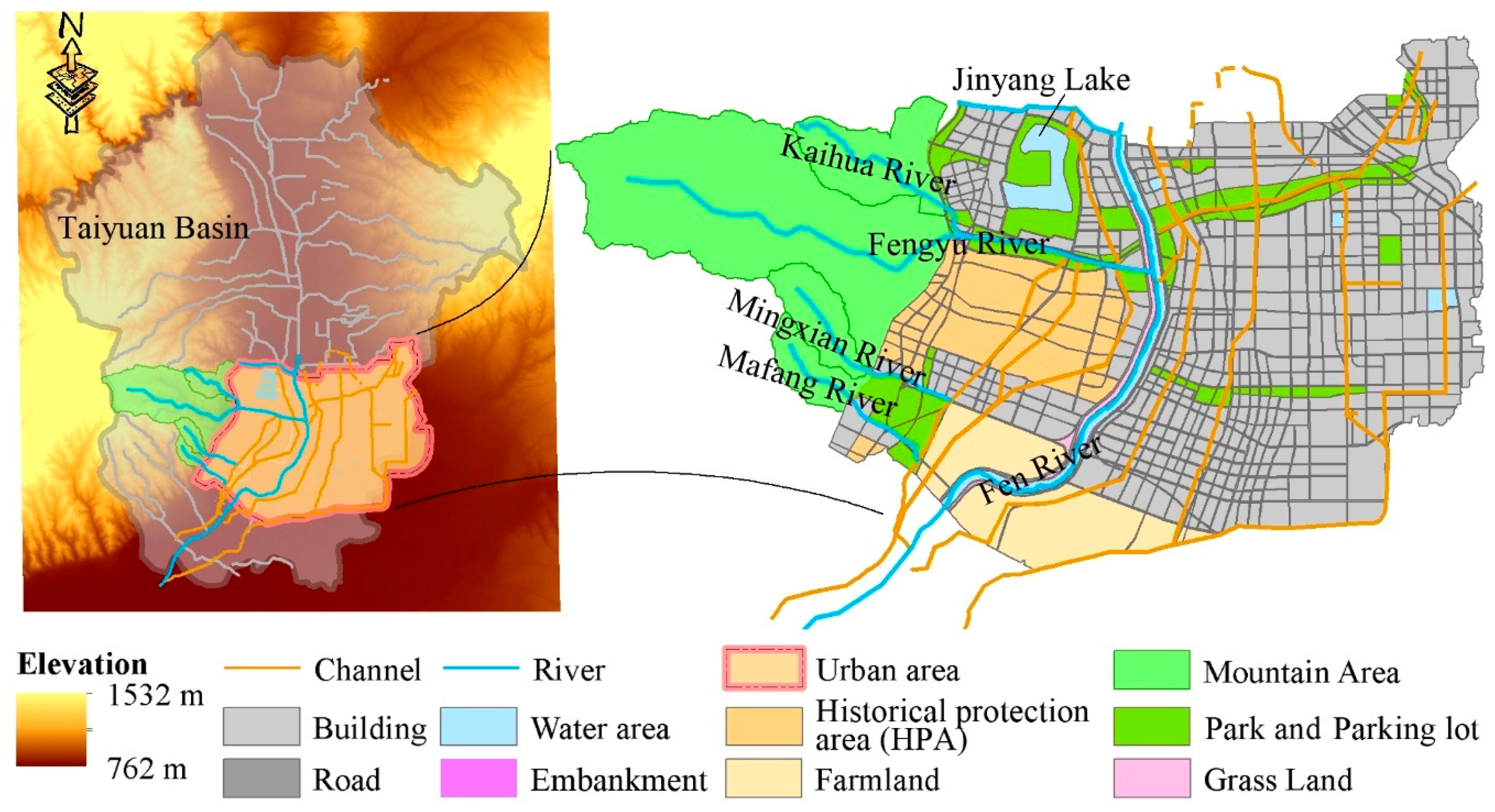
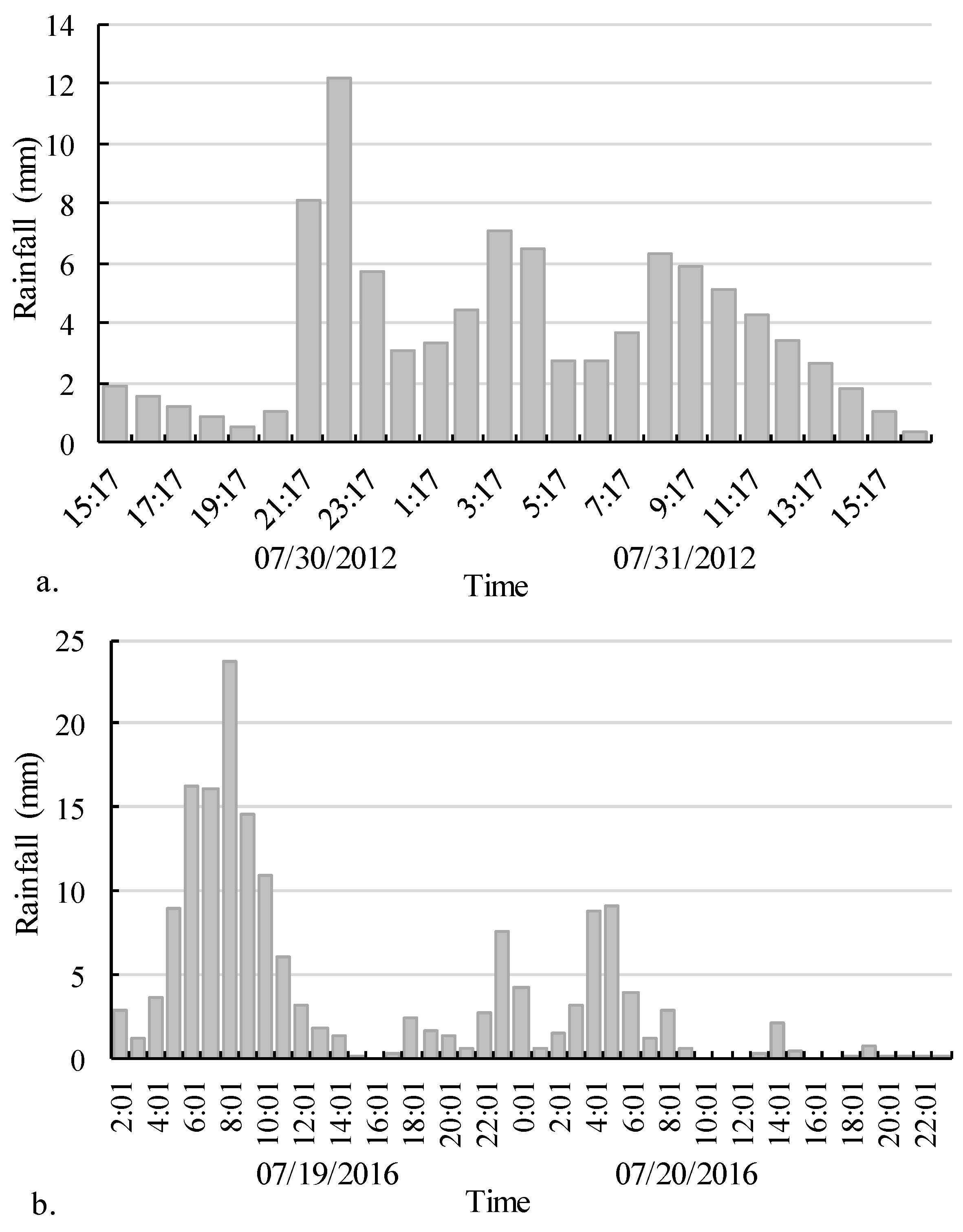

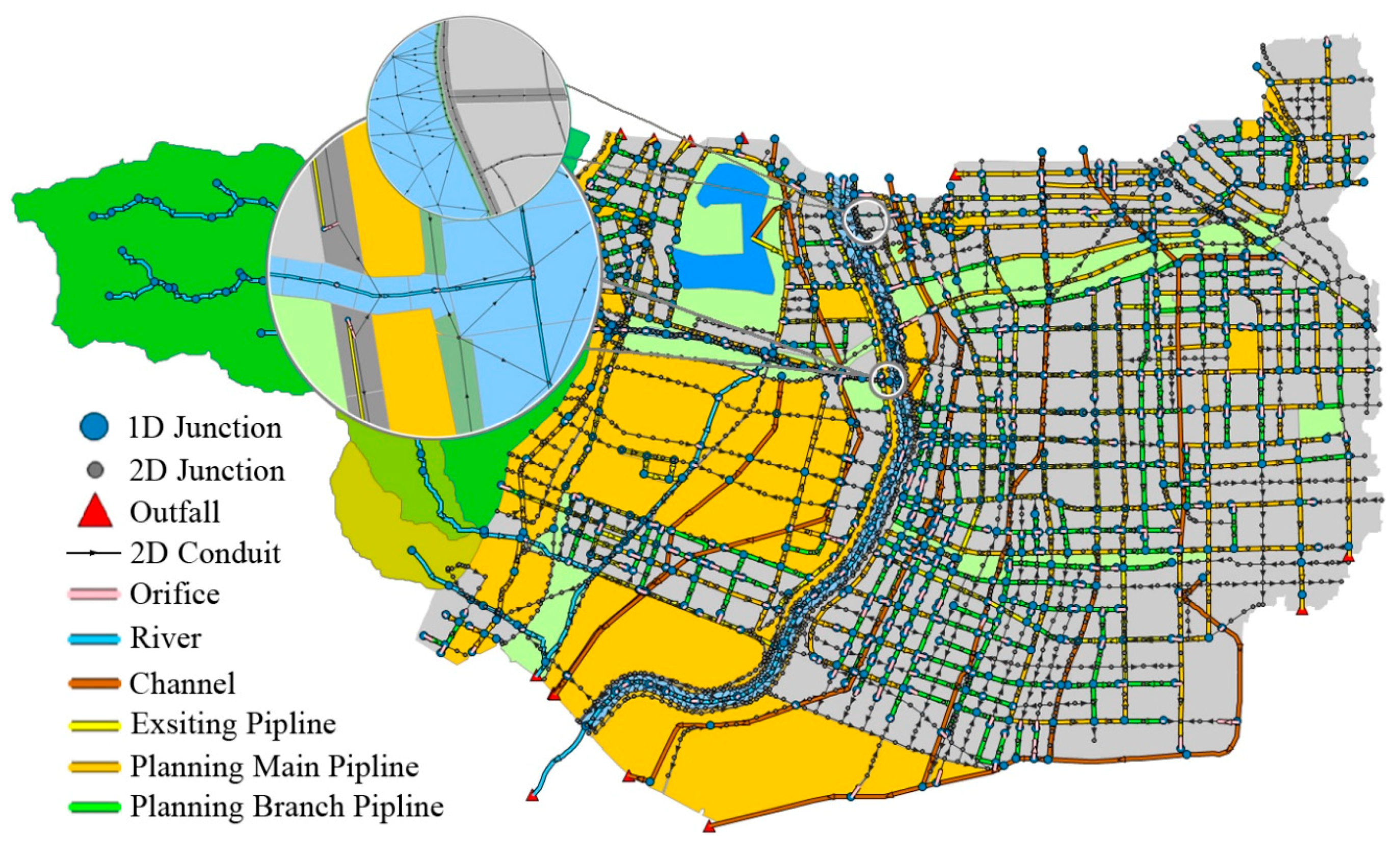
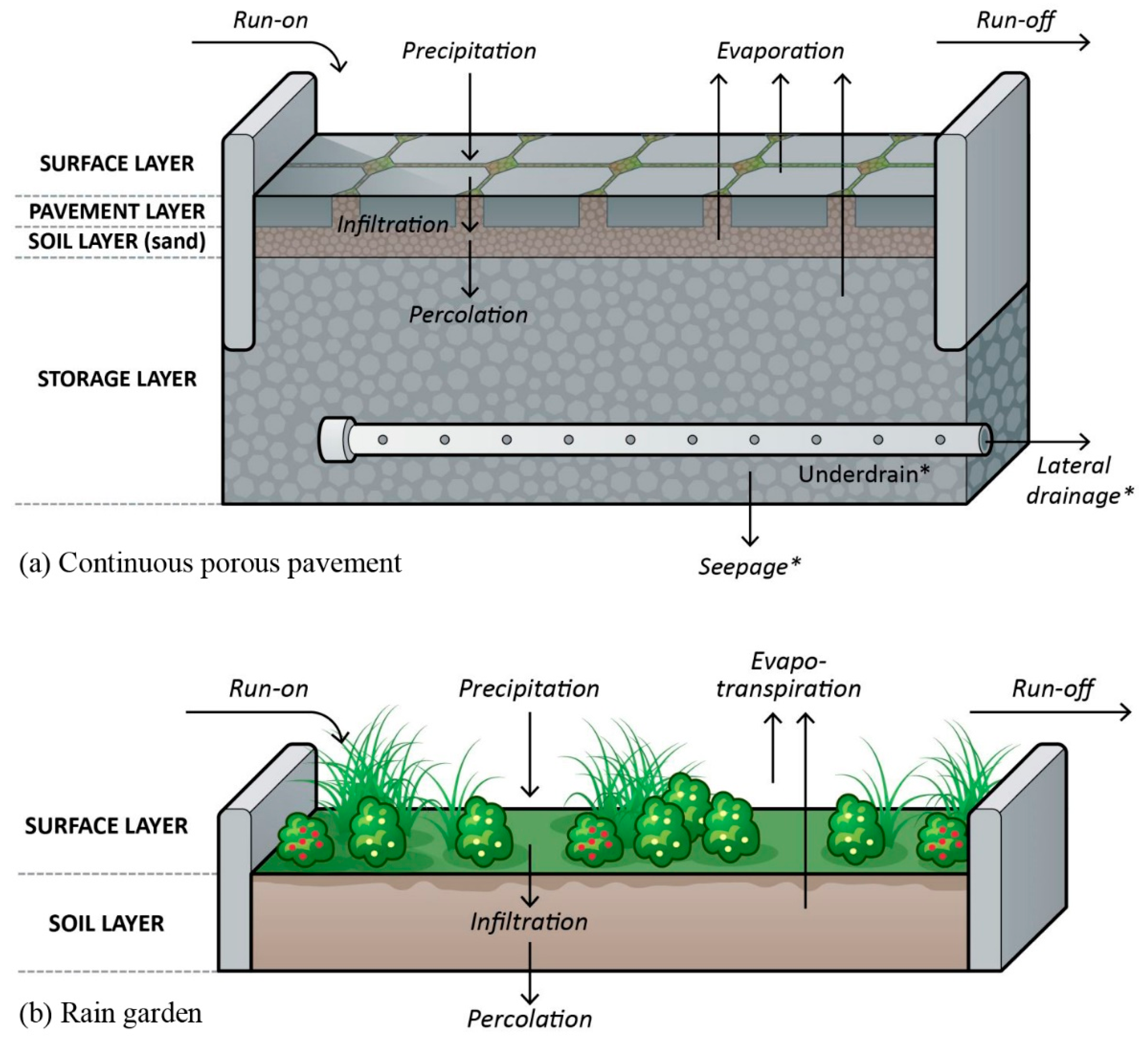
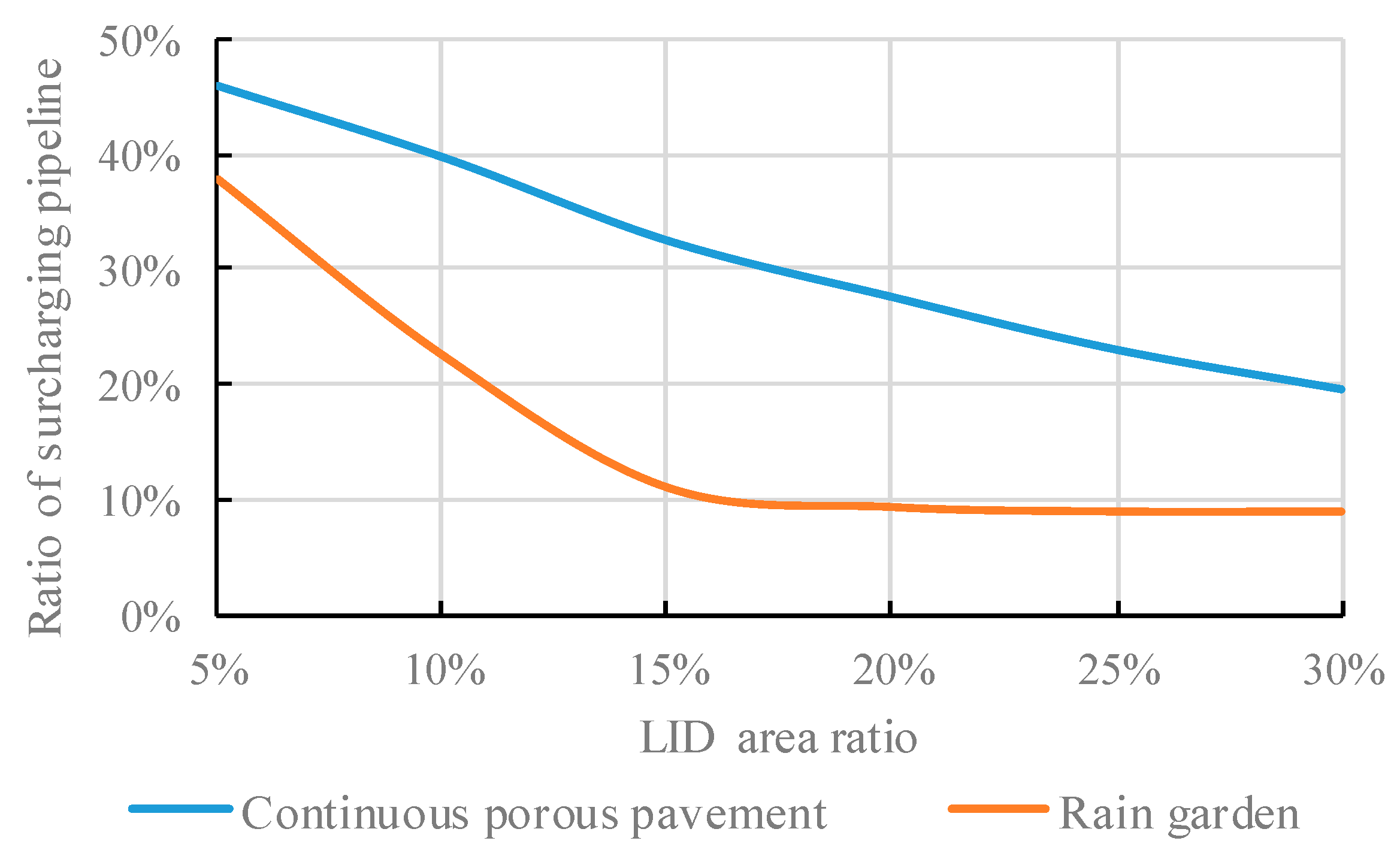

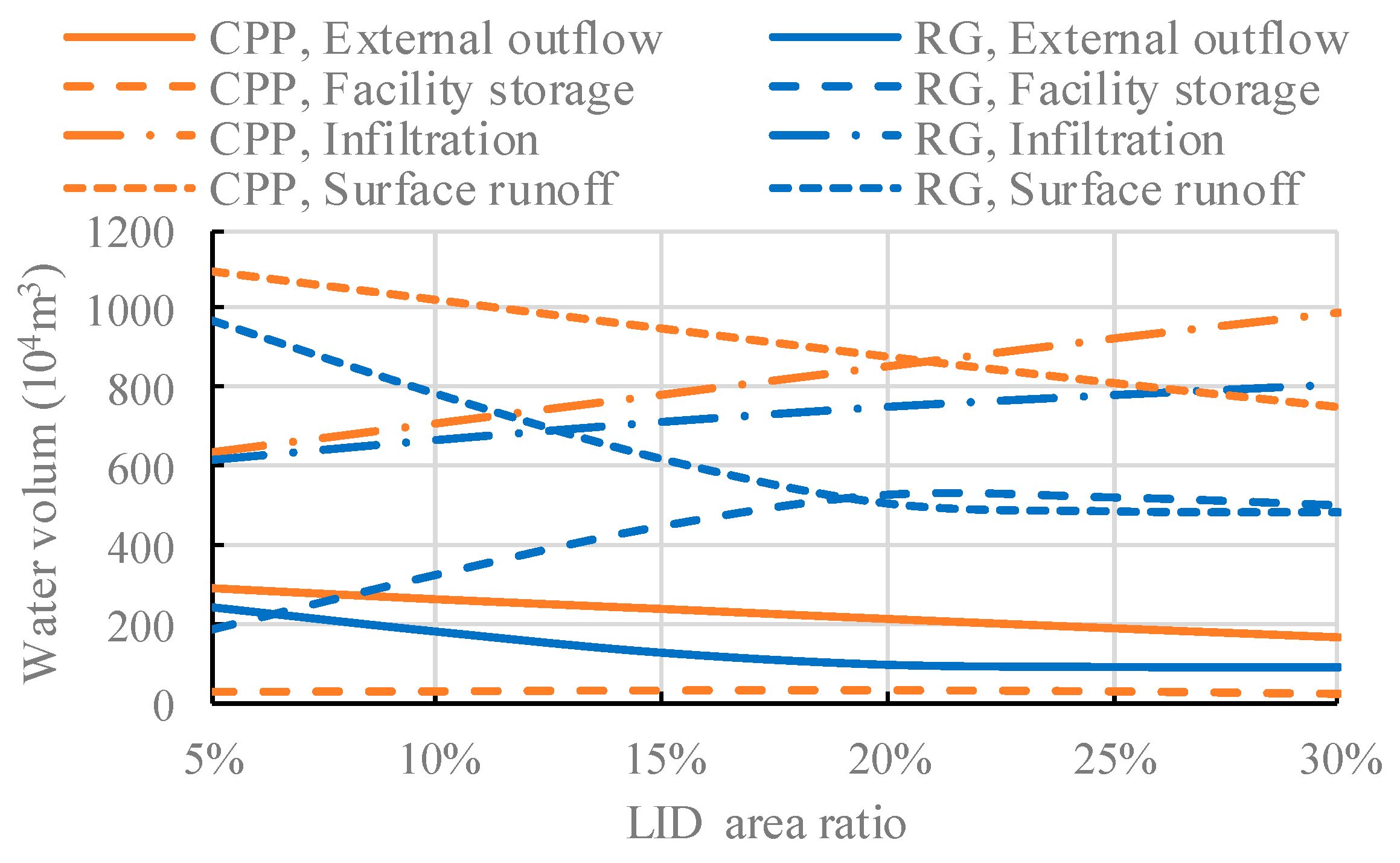
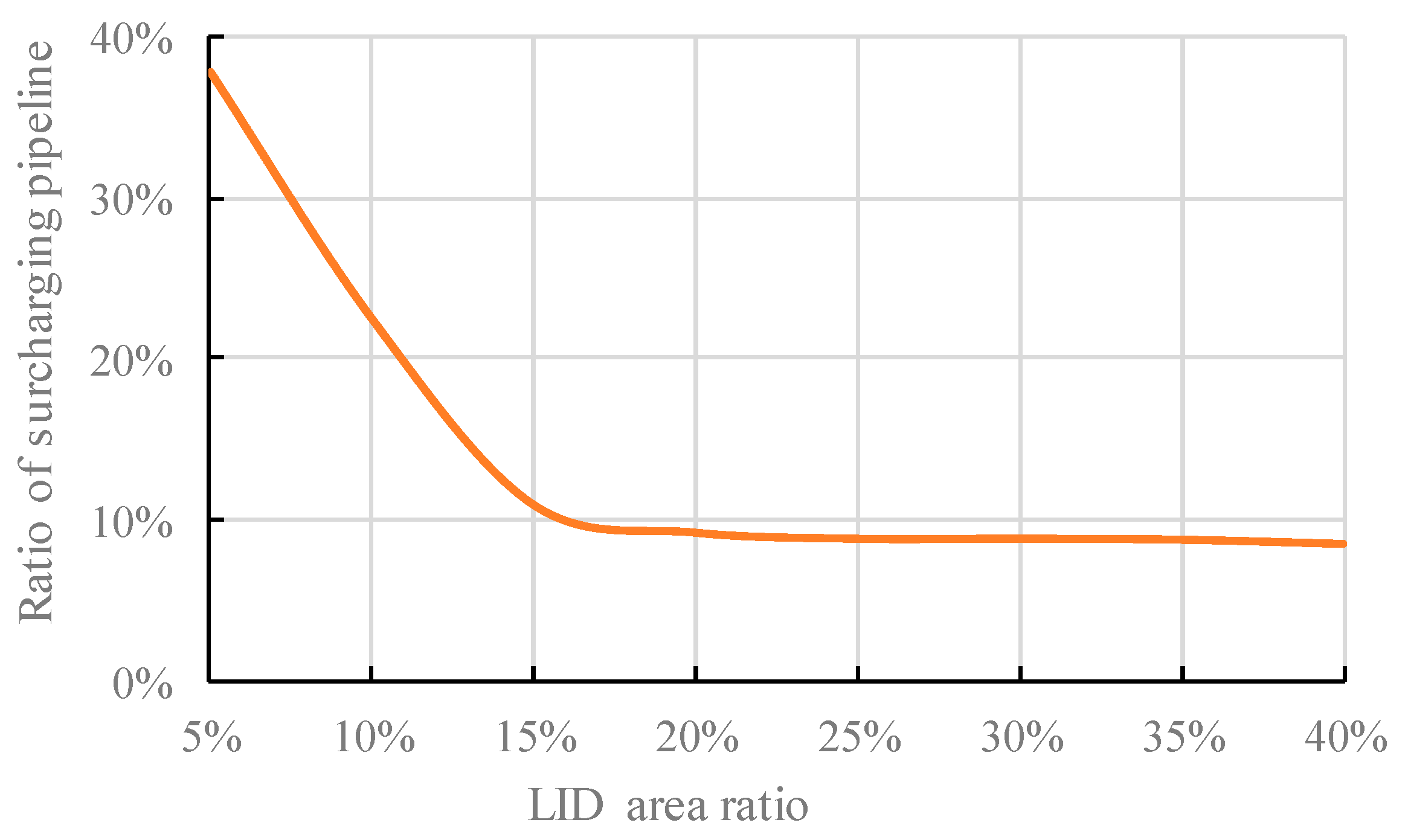

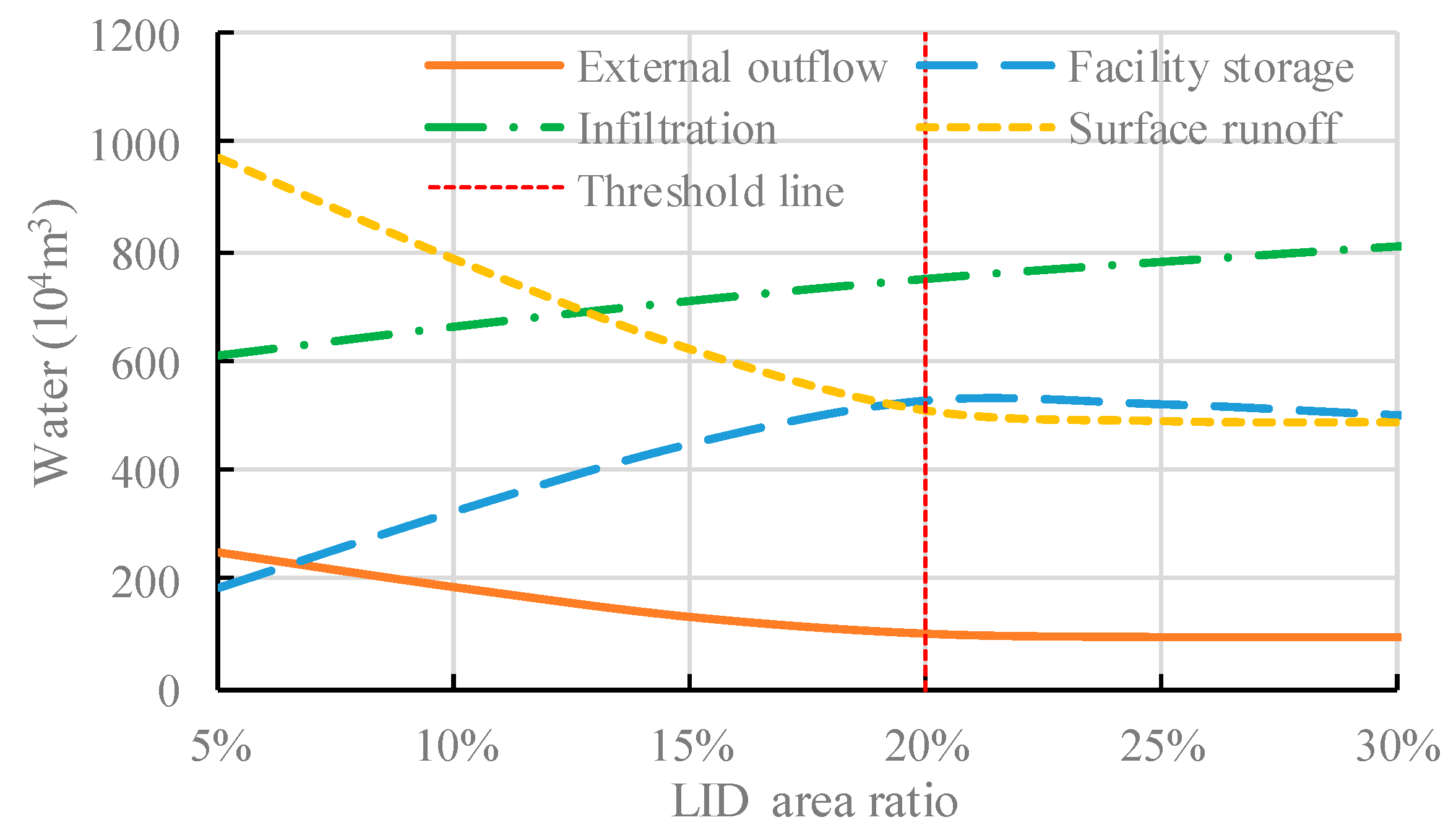
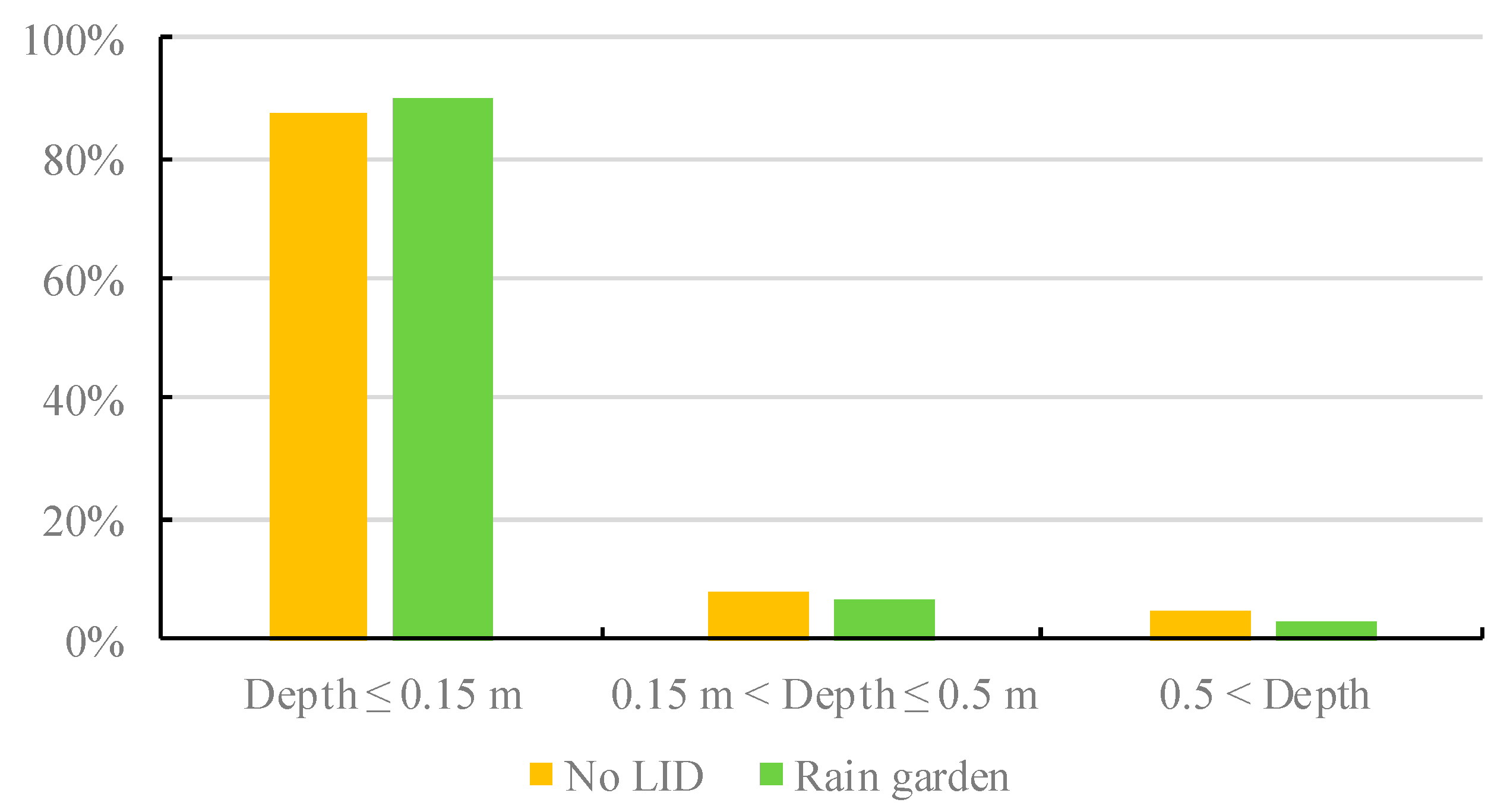
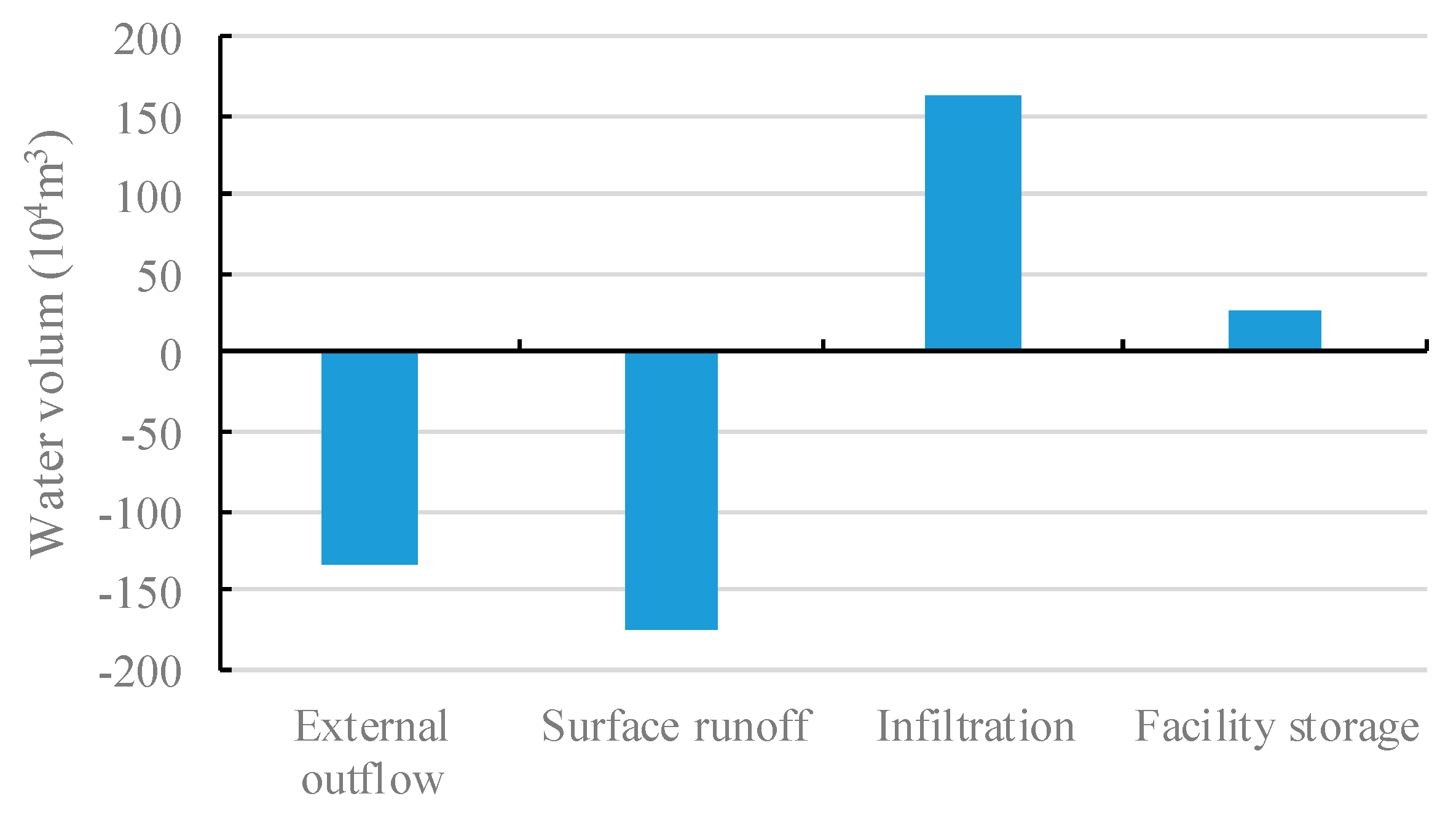


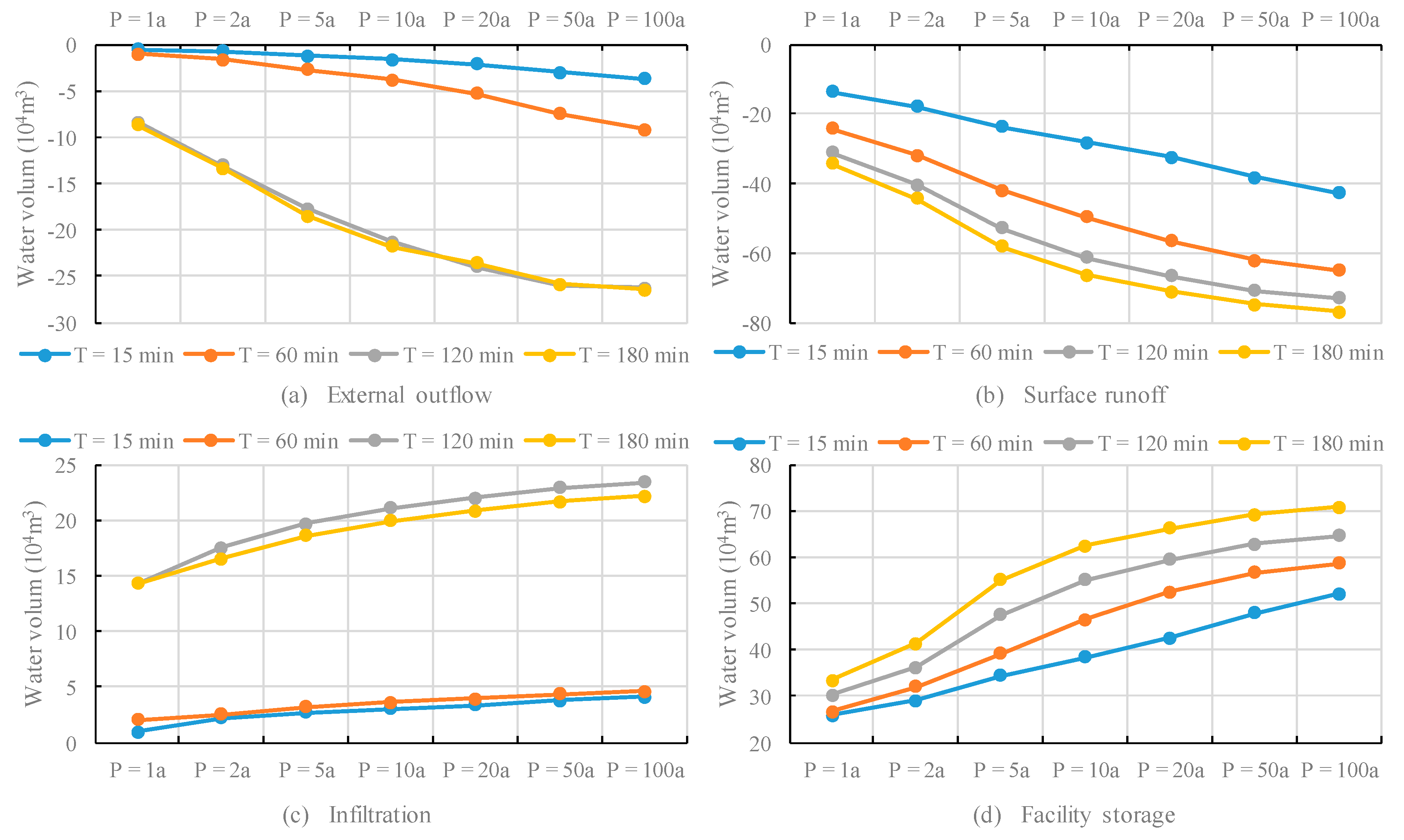
| Land Use | Percent of the Study Area | Empirical CRC | Simulated CRC |
|---|---|---|---|
| Building | 56% | 0.85~0.95 | 0.94 |
| Green land (including park, embankment, and grass land) | 12% | 0.10~0.20 | 0.11 |
| Historical protection area (HPA) | 11% | 0.35~0.40 | 0.37 |
| Road | 9% | 0.85~0.95 | 0.95 |
| Farmland | 9% | 0.10~0.20 | 0.17 |
| Water area | 3% | 1.00 | 1.00 |
| Land Use | Max. Infiltration (mm/h) | Min. Infiltration (mm/h) | Decay Coefficient (1/h) | Drying Time (day) |
|---|---|---|---|---|
| Building | 10 | 4 | 4 | 7 |
| Green land | 12 | 6 | 4 | 7 |
| HPA | 10 | 4 | 4 | 7 |
| Road | 10 | 4 | 4 | 7 |
| Farmland | 12 | 6 | 4 | 7 |
| Conduits | Manning’s Roughness Coefficient |
|---|---|
| Fen River | 0.03 |
| Fengyu River | 0.03 |
| Kaihua River | 0.03 |
| Mingxian River | 0.03 |
| Mafang River | 0.03 |
| Channels | 0.02 |
| 1D Pipelines | 0.014 |
| 2D Conduits | 0.011 |
| Parameters | Building | Greenland | HPA | Road | Farmland |
|---|---|---|---|---|---|
| Percent of impervious area (%) | 90 | 2~12 | 15 | 95 | 1 |
| Manning’s n for impervious area | 0.011 | 0.011 | 0.011 | 0.011 | 0.011 |
| Manning’s n for pervious area | 0.15 | 0.15 | 0.15 | 0.15 | 0.06 |
| Depth of depression storage on impervious area (mm) | 0.05 | 0.05 | 0.05 | 0.05 | 0.05 |
| Depth of depression storage on pervious area (mm) | 2 | 2 | 2 | 1 | 6 |
| Layer | Parameter | Value |
|---|---|---|
| Surface layer | Manning’s n | 0.1 |
| Slope | 1.0 | |
| Pavement layer | Thickness (mm) | 100.0 |
| Void ratio | 0.2 | |
| Impervious surface | 0.0 | |
| Permeability (mm/h) | 100.0 | |
| Storage layer | Thickness (mm) | 100.0 |
| Void ratio | 0.75 | |
| Seepage rate (mm/h) | 20.0 |
| Layer | Parameter | Value |
|---|---|---|
| Surface layer | Berm height (mm) | 150.0 |
| Vegetation volume | 0.05 | |
| Manning’s n | 0.16 | |
| Slope | 1.0 | |
| Soil layer | Thickness (mm) | 500.0 |
| Porosity | 0.3 | |
| Field capacity | 0.2 | |
| Wilting point | 0.1 | |
| Conductivity (mm/h) | 20.0 | |
| Conductivity slope | 10.0 | |
| Suction head (mm) | 3.5 |
© 2019 by the authors. Licensee MDPI, Basel, Switzerland. This article is an open access article distributed under the terms and conditions of the Creative Commons Attribution (CC BY) license (http://creativecommons.org/licenses/by/4.0/).
Share and Cite
Cui, T.; Long, Y.; Wang, Y. Choosing the LID for Urban Storm Management in the South of Taiyuan Basin by Comparing the Storm Water Reduction Efficiency. Water 2019, 11, 2583. https://doi.org/10.3390/w11122583
Cui T, Long Y, Wang Y. Choosing the LID for Urban Storm Management in the South of Taiyuan Basin by Comparing the Storm Water Reduction Efficiency. Water. 2019; 11(12):2583. https://doi.org/10.3390/w11122583
Chicago/Turabian StyleCui, Tingting, Yuqiao Long, and Yintang Wang. 2019. "Choosing the LID for Urban Storm Management in the South of Taiyuan Basin by Comparing the Storm Water Reduction Efficiency" Water 11, no. 12: 2583. https://doi.org/10.3390/w11122583
APA StyleCui, T., Long, Y., & Wang, Y. (2019). Choosing the LID for Urban Storm Management in the South of Taiyuan Basin by Comparing the Storm Water Reduction Efficiency. Water, 11(12), 2583. https://doi.org/10.3390/w11122583




